Audience Participation
Do Taylor Mac et al Tickle or Terrify?
Taylor Mac hates when the cast of a show tries to get the audience to participate on stage: “They always say it’ll be fun. F*** you, I don’t want to have fun.” But that is how he feels when he is a member of the audience. “It’s different when I ask you to participate,” he said to his audience from the stage of New York Live Arts in Chelsea. “I want you to feel uncomfortable.” Mac was saying this during his show, A 24-Decade History of Popular Music, that turned out to be the most extreme recent example of the practice of audience participation—which, if you happen to be sitting in the audience terrified you’ll be picked, is an alarming trend.
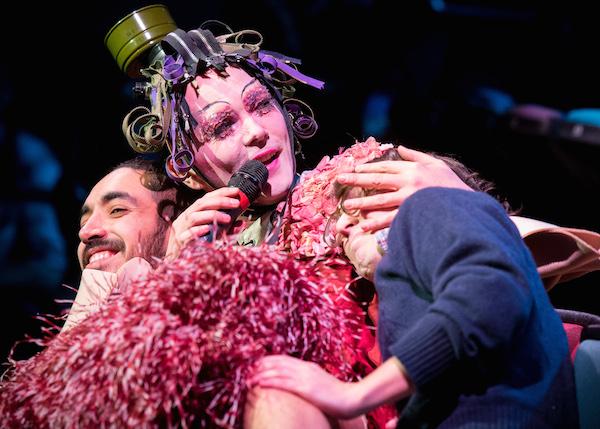
“Audience Participation” Defined
“Audience participation” is a vague term, like much of theatrical terminology; it has come to mean different things to different people.
The term was used for Natasha, Pierre and the Great Comet of 1812, where the audience sat at little bistro tables during the performance and ate a meal, with the performers snaking around the tables, and occasionally sitting down at one. Then there are the shows where the audience has to stand up. These are sometimes labeled “immersive” (another vague term) and are heralded as a new way for audiences to participate. In Here Lies Love, we stood in a convincing replica of a disco at the Public Theater as the show about Imelda Marcos unfolded around us. Guides in orange safety vests occasionally moved us to one corner of the room, and then to another; we at times were encouraged to dance. In Sleep No More, a fractured, multi-roomed presentation of Macbeth in an old hotel converted for the show, much has been made of the audience being in charge; we can see scenes in whatever order we want, and we can open drawers and cabinets.
There are shows, such as The Mystery of Edwin Drood, where the audience gets a say in how the plot unfolds—the audience as playwright’s helper. Audience participation takes on a different connotation in overtly political companies such as Theatre of the Oppressed, which has created separate troupes made up of LGBT youth, HIV-positive homeless New Yorkers, and undocumented immigrants and refugees, while their audiences are urged to take the struggle to City Hall, sometimes literally.
But what happens when the audience participates by becoming performers—without volunteering to do so?
Taylor Machinations
A 24-Decade History of Popular Music is an ambitious “performing arts concert” that next year Taylor Mac plans to present in a 24-hour marathon of American music from 1776 to 2016. Last month, as part of the Under the Radar festival, he presented seven hours of it over two separate nights, singing some seventy songs from the 1900s to the 1950s, which I reviewed favorably.
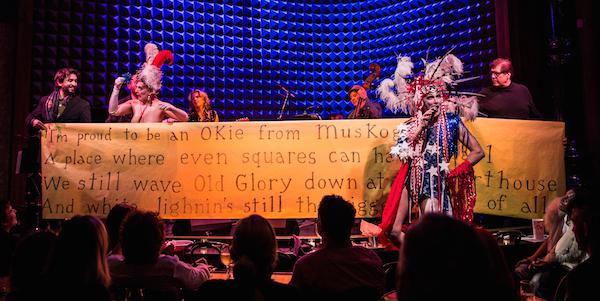
By the end of the shows, Mac had volunteered every member of the audience to participate in one way or another. Some of this was benign, such as blowing up balloons for him, or sing-alongs. Some of the sing-alongs were straightforward (we sang the lyrics written on a makeshift poster held up on the stage), some of it cleverer: Mac instructed half the audience to sing “It’s Time For Every Boy To Be A Soldier,” and the other half to sing “I Didn’t Raise My Boy To Be A Soldier” to show conflict over U.S. entry into World War I. I found some of the audience participation physically uncomfortable: Row by row he told us to get out of our seats and sit on the floor of the stage, until the seats were empty and the stage was full. What he was doing became clear as he sang songs of crowded tenement life on the Lower East Side in the 1900s. (We were permitted—eventually—to return to our seats.)
However, Mac also picked individual members of the audience to play gay lovers, and his own lover. The stage went dark, and when the lights came back on we saw Mac had wrapped his arms and legs lasciviously around a gentleman. In the 1940’s segment, he put Nazi armbands on two audience recruits. In the 1950’s, he told all the white people to stand and move to the suburbs, leaving the handful of people of color sitting in the largest, now emptied middle section.
These more intrusive moments in Mac's show made me cringe. Perhaps I'm just out of step: The picked-on people seemed to be enjoying themselves.
Every Brilliant Thing
Every Brilliant Thing, a play by Duncan Macmillan that I called in my review a funny, fun, and moving show, is about a boy who begins writing a list of “everything worth living for” to cheer up his suicidal mother. Before the show, Jonny Donahoe, the sole (paid) performer in it, rapidly circulates among the audience at the Barrow Street Theater and hands out little slips of paper with a brilliant thing and a number. (I got number 5 “Things with stripes.”) Then throughout the show, he calls out the numbers and has us recite aloud the assigned thing worth living for. But he went further, recruiting audience members to play characters in the story of his character’s life—the veterinarian who put his dog to sleep, his father, his first love. Sometimes Donahoe prompts the impromptu performers with simple lines of dialogue. Sometimes they are left to their own devices—such as the person who is asked to describe a book he hands her as if she’s been reading it, or the audience member asked to make a formal speech at a family gathering. The most intrusive demand was for the “school counselor” to take off her shoe and sock so that she can use her sock as a sock puppet—which he explained would put the child patient (the character he is playing) more at ease, although it’s less likely to do the same for the audience member.
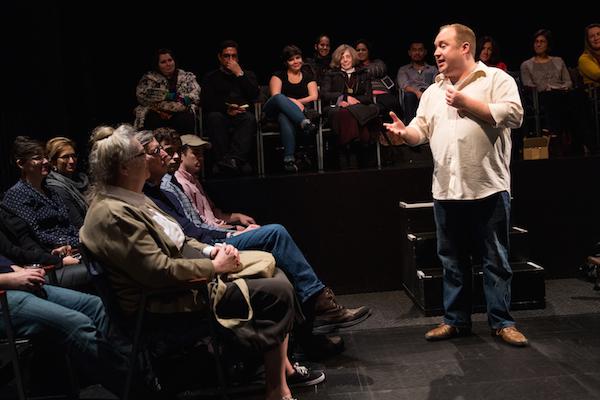
To those who see aggressive audience participation as the cutting edge, even the future, of theatre—who talk about its emergence from video gaming and the digital revolution, etc.—it might be instructive to point out that audience participation is as old as English Pantomime...
Mrs. Mayfield’s Reunion
My most recent experience with audience participation occurred at a show called Mrs. Mayfield’s Fifth-Grade Class Of ’93 20-Year Reunion. Created by Mariah MacCarthy and the ensemble from her Caps Lock Theatre Company, the show was held in a fifth-floor walk-up apartment on the Lower East Side. Before it even started, then, it was making an extraordinary demand on its audience, which seems part of the appeal of these shows, helping us to think of ourselves as people who are as committed to the cool and unconventional as the show we’re literally breathless to see.

At the door to the apartment we were greeted one by one by Amanda (Diana Oh), who hugged us and led us to the nametags and the booze. It took a long time for me to be able to distinguish the performers from the audience members, since we were all milling about, drinking, and the performers chatted on occasion with the spectators. A clue was that most of the performers made their entrance late and by themselves. There was something pitch-perfect in the way Mrs. Mayfield’s Reunion captured the rhythms and dynamics of a party—how little simultaneous pockets of conversation alternated with brief may-I-have-your-attention speeches; how the general chaos of conversation was punctuated by private moments gone suddenly public of tense glaring or outright arguing, how the proceedings deteriorated into too much drinking and taking drugs, then illicit smooching and late-night soul-baring. It was only after the party ended that we were given a program. Some audience members might be surprised to learn that it is a completely scripted show.
There are several ways in which Mrs. Mayfield’s Reunion differed from Taylor Mac’s performance art concerts and Every Brilliant Thing. Before we even made the climb up those stairs, a Caps Lock staffer handed us a page of explanation and instruction, which included the information that any audience member could opt out of active participation simply by putting a red dot on their name tag; none of the actors would engage the red-dotted spectator in conversation. There was no opt-out option in either other play. We had, at best, to trust that the performers were expert enough at reading vibes to pick who would be open to the public exposure. (In interviews Jonny Donahoe says that he “creates a relationship with about eighty people very quickly” when he’s handing out the slips of paper, enabling him to scope out who would be open to performing.) At worst, we were terrified they didn’t care what we wanted, and we resorted to the sort of tricks learned in elementary school to avoid being called on by the teacher—no eye contact, deep engagement in some activity on the floor, working hard at becoming invisible.
A Distraction
There is another difference. I am not sure that Mrs. Mayfield’s Reunion would have worked as well as a traditional play—told in a linear way on a proscenium stage. But I am certain that the other two would have worked without turning the spectators into performers. I’ll concede that the popularity of these shows may well have been not in spite of their aggressive audience recruitment but in part because of it. But that’s for other people who attended, not for me. I felt their use of this technique went too far, becoming a distraction rather than an enhancement. Every Brilliant Thing tells a substantive, engaging story about a boy growing into a man learning to fight depression. Donahoe, who has a background as a comedian, has a gift for interacting with the audience, but he’s doing so as himself, not as the character. Coupled with a kind of audience performance anxiety, the result, for me, was to be jerked too often out of what novelist John Gardner called the continuous vivid dream of the narrative.
Imagination, and “Memories”
Some argue that the audience participates in every live stage show, by applauding and laughing and crying; even staying silent is a communication with the cast. We also participate in our own minds, and emotionally, by being absorbed in the story and the characters. At a talk-back to a show I attended this week, Israeli Stage artistic director Guy Ben-Aharon said he likes staged readings because “the audience is forced to participate more than in fully-staged productions.” By this, he meant they had to engage their imaginations.
To those who see aggressive audience participation as the cutting edge, even the future, of theatre—who talk about its emergence from video gaming and the digital revolution, etc.—it might be instructive to point out that audience participation is as old as English Pantomime, that it was hip half a century ago when the Living Theatre indulged in it, and that audience manhandling hit the mainstream as far back as Cats.

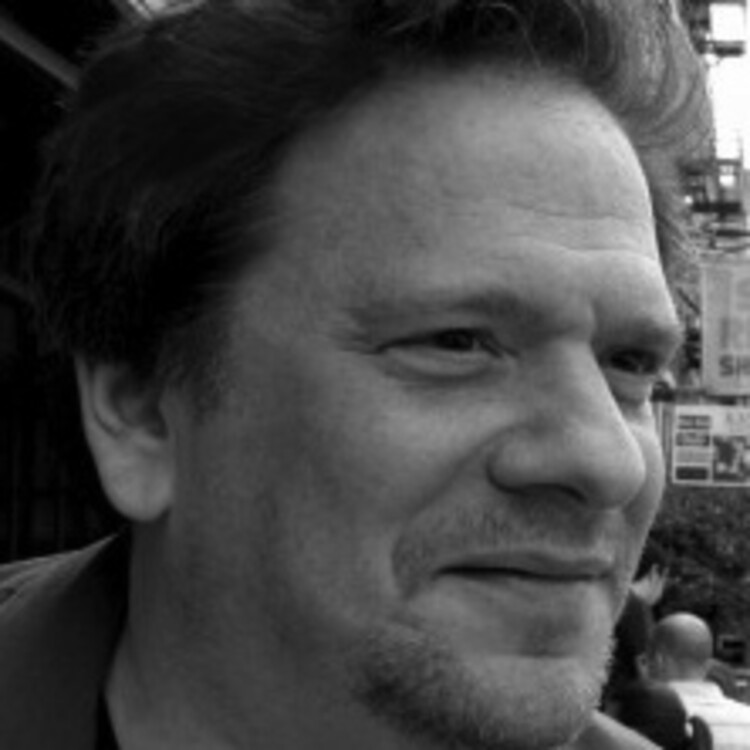
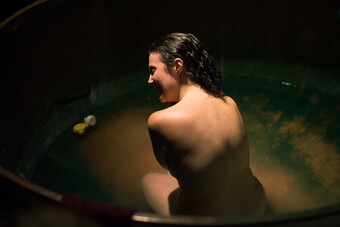

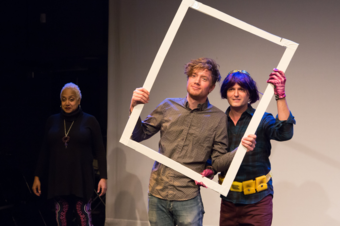

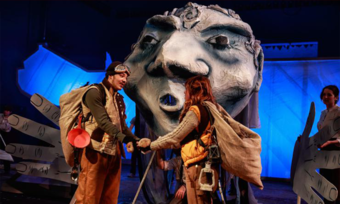

Comments
The article is just the start of the conversation—we want to know what you think about this subject, too! HowlRound is a space for knowledge-sharing, and we welcome spirited, thoughtful, and on-topic dialogue. Find our full comments policy here
If it works, ppl will love it, and keep seeing the show. If not, a few ppl will have a few moments of mild to extreme discomfort, and the show will go away. This is the process. There's nothing more to it, and artist should by all means resist any voice of reason or moderation. Art is not for the reasonable or the moderate, but for he zealous and shrewd.
I have mixed feelings about audience participation. I had a lot of fun with the intermission interaction at the San Francisco production of The Lily's Revenge, where I had dinner conversations with strangers and briefly danced with a member of the cast (who I then had the pleasure to see in other local plays).
But you can't assume your audience is physically capable of doing what you're going to spring on them. Standing for two hours or sitting on the floor for even a short time just aren't going to work for me, as are certain physical interactions, and you can't tell that just by looking at me. Actually, I've gone to theatre when I've been voiceless and wouldn't be able to verbally interact either.
This is a great piece about audience participation from the audience's perspective. Thank you.
For current research with theoretical structures (that I'm aware of... these are a few years old now), see:
Spectrum of audience involvement (how audiences interact with artists and with each other): https://www.irvine.org/arts...
Arc of engagement (how audiences interact with the entire experience of attending an arts event – from first touch to post-show processing): http://wolfbrown.com/compon...
Defining Participation in “Non-Participatory” Art: http://www.artivate.org/?p=163
I had the pleasure of being in the audience for the premiere of Taylor Mac's The Lily's Revenge at HERE Arts Center in 2009. It was a five-act, 30-plus actor extravaganza where the audience was given ample opportunity to participate, not only during the show but during the intermissions. I have very fond memories of dancing with drag and burlesque performers on stage, and with going down to the dressing room to talk to performers between acts. It remains one of my favorite theatrical experiences.
Could Taylor have done this on a proscenium stage with little to no audience participation? Sure, he could have. The story would still have worked. We still would have understood the tale of this flower's journey to be a man. But the art--that specific, engaging, magical experience he created--would have been ruined.
Audience engagement is like any other aspect of theatrical storytelling--it can be done clumsily and poorly and be nothing more than an unnecessary add-on. But done well by artists who understand the dynamics of performance, it becomes an integral part of the art. Something that can't be removed without the show falling apart or becoming something entirely other.
Sometimes engaging the audience directly makes them uncomfortable. And sometimes (especially in the hands of artists like Taylor), it's meant to.
I acknowledge Taylor Mac to be an artist of awesome talent. You are
talking about a different Taylor Mac show than the one I was writing
about. In the one I was writing about, I thought some of the audience
participation worked well, and some of it didn't work for me.
You use "audience engagement" as if it's synonymous with "audience
participation" -- a reflection, I think, of the vagueness of so much
theatrical terminology. To me, they're not the same. Engagement to me
implies something the audience member comes to on his or her own, internally --
inspired or provoked by the work...but not forced by the artist.
I might have been writing from a place of defensiveness for one of my favorite artists. I recognize Lily's Revenge is a different show and the audience participation/engagement likely works differently in Popular Music. I think my main point is that aspects of the show that involve the audience are like any other moving part of a dramatic work. Just like dialogue and plot points and scenic design--it's great when done well and painful when done poorly. Sometimes painful when done well, if that's the artist's intent. But whether it works or not, if you remove that piece of it, it becomes a different work of art.
I think I might also be responding to more than just your blog post. There's a flip side to those people calling it "cutting edge" and it's the many people I've heard dismiss it as a fad. As you noted, audience participation has deep roots. And as Teresa mentions farther down, it's a tool that's evolving and expanding with the times.
You seem to have focused on a single line in my piece -- two of the three works "would have worked without turning the spectators into performers" -- that maybe I should have omitted ,since it's kind of irrelevant to my main point in that section: I felt that some of the audience participation was a distraction from, rather than an enhancement of, what was best about these pieces.
I'm sure there's a take-it-or-leave-it argument to be made about artistic endeavor, similar to what I've heard devout Catholics say: Catholicism is not a cafeteria religion; you can't pick and choose the elements of the faith to practice. Artistic analogy: You must take a work of art as a whole, not analyze its individual parts/pick it apart. You need to respect artistic integrity (the etymology of "integrity" derives from "wholeness")
I can see someone making that argument, but I don't agree with it.
Yep. Didn't realize it, but it was that line. And I agree with you--I definitely think you can analyze a piece by its component parts. Criticism doesn't threaten a work's integrity.
I saw Lily's Revenge in SF. It did not translate to the new location. The audience participation felt clumsy and an unnecessary add-on... for what it's worth
Audience participation, to me, is easier for the performers when it is controlled. Laying out a set of ground rules like we do each night in Mrs. Mayfield helps us navigate the waters while still having the breathing room to be real people (Ya know, like they teach you in them actin' schools). If our show allowed audience to be come into the party all willy nilly the play would suffer greatly (and be like 3 hours long). You have to help the audience trust you that the rules, be they many, are there for you to have as complete of an experience as you can have with us. We've got you. We promise.
As a performer, though, this show gives me the greatest and easiest passage into naturalism than anything else. Just being literally face to face with your "other members of the class" forces you to dial down projection or fancy line reads. I've learned more about acting doing this show than I have in any you-sit-there-we-stand-here performance. It's not unlike on-camera acting but the lens is even sharper in that the audience is taking every part of you in as one would when meeting someone at a party. From time to time I get a judgmental up-down look when my character Joey walks in and I'll tell you what, that is more frightening than any camera will ever be!
I think Taylor Mac has the right idea in that audience participation is an art form. It is almost another beast entirely from traditional theatre or even that elusive bubble of performance art, like a first cousin. But this isnt brand new. This has been done for years but I think this kind of art is rebirthed from a desire to side-step our sometimes stagnant American theatre. Happy to see it making a resurgence and even more happy to see that it sells tickets just as well as anything else in NYC.
Taylor Mac Tweeted the following comment: "Audience Participation is an art form. Art forms aren't things to like/dislike. They are tools to deeper consideration."
Expectation is important. I work very hard to make sure the audience knows what they're in for when they buy a ticket. So much so that I've started moving away from the word "theater" and toward words like "play space".
Having gone to Taylor Mac's first UTR performance of the concert a few years ago, I love reading in this how he's evolving his audience participation--he talked about his dream of getting the entire audience onstage for the tenement thing and now he's doing it!
As for audience participation, I think a lot of it has to do with expectation. Going to a Taylor Mac show, I expect to be involuntarily involved because that's what he does.
Both personally and professionally, I find audience participation to be an interesting subject. On the one hand, I appreciate and applaud the continual evolution of theatre -- be it going back to the audience participation of the past but in a refreshed way or new innovations, both of which can expand the field. So I encourage and support the inclusion of audience participation. Also, as someone who has done Theatre of the Oppressed work as well as facilitates post-show discussions with TYA new play development, I very much want audience participation when I seek it!
On the other hand, as an audience member, I am much more tentative. My personality is such that I just want to be able to sit back and observe. I don't want to participate unless the spirit moves me :-). That being said, I also know it's beneficial to get out of my comfort zone from time to time. I also recognize that theatre isn't necessarily supposed to allow me to be complacent, to merely observe the players and then go home, so to speak. So there are times when it's "good" for me to feel uncomfortable and to be encouraged if not forced to participate. I may hate it, but I may learn something from it (depending on the context, of course, and assuming the discomfort isn't just done for shock value, but has a legitimate purpose -- at least that's my criteria for accepting the discomfort; I know others will hold different criteria).
Anyway, that's all to say that I find this a fascinating topic to explore.
I did a lot of this stuff myself back in the 90's but I think it will more likely keep people away from the theater instead of encouraging them to go. There's certainly nothing revolutionary about it.